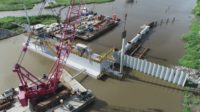Nearly five years into the execution of Louisiana’s long-range plan to halt and reverse the loss of coastal land, state officials are drafting the first five-year update.
At least two major projects will be completed this month, and small, independent projects are demonstrating innovative approaches to protecting vulnerable berms and levees.
The 2012 Comprehensive Master Plan for a Sustainable Coast outlines a 50-year blueprint for reducing hurricane flood risk and achieving a sustainable landscape. The cost of that work is widely but informally estimated at $50 billion.
From 1932 to 2010, Coastal Louisiana suffered a net loss of 1,833 sq miles, an area nearly the size of Delaware that represents 25% of the 1932 land area, according to the U.S. Geological Survey. In 50 years, a Katrina-type storm could cause more than $133 billion in damage to the unshielded coast, says a report commissioned by the Coastal Protection and Restoration Authority (CPRA).
Weeks Marine Inc. is the prime contractor on two of the largest coastal-restoration projects the state has done, says Steve Chatry, senior vice president and dredging division manager. One project, the $100-million Bayou Dupont, replaces degraded marsh with Mississippi River sand pumped via a 72,000-ft pipeline.
The other project, the $140-million Caminada Headland Beach and Dune Restoration Project, is replenishing 14 miles of severely degraded beach with material dredged 10 miles offshore to bolster and preserve the structural integrity of the barrier shoreline that “protects a very important facility at Fourchon,” Chatry says. “They have a lot of offshore vessels that go in and out, and they service the deepwater oil industry.”
Coastal Engineering Consultants Inc. is the construction manager and prime consultant for design, permitting and construction. Bayou Dupont has just been completed and demobilized, and Caminada Headland will be completed in mid-October.
On a bank of the Gulf Intracoastal Waterway, a small-scale project is demonstrating a low-cost method to armor an eroding levee and halt its degradation. In partnership with Ducks Unlimited, the America’s Wetland Foundation contracted with Martin Ecosystems to install one mile of EcoShield for $1 million.
“A lot of times in Louisiana when we’re trying to protect our levees, we try to vegetate them. But if the soil’s not very good and they’re too loose and the plants don’t really have anything to root into and hold onto, they end up washing away,” says Nicole Waguespack, president. Martin designed a matrix made from recycled PET plastic, which “looks like and feels like a large Brillo pad,” Waguespack says. The EcoShield matrix, prevegetated in the nursery, is ready for installation in 30 to 60 days. “When we put it out there, there’s already an established vegetation at the water line, then we also plant the upper part of the matrix.” The entire area may be fully vegetated in six months to a year.
Ted Falgout, a coastal restoration expert and part owner of the levee protected by EcoShield, considers the project a success. A barge has partly damaged one spot in the EcoShield, “but all the rest of the mile-long project has been totally stabilized,” he says. Where the project ends, the ground has been eroded another 15 to 20 ft inland just in the few months since it was completed.












Post a comment to this article
Report Abusive Comment